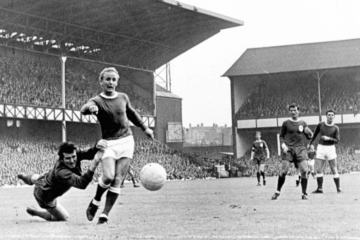‘Parker was a grand leader, strong, virile, earnest – as unruffled as his massive locks.’
Will Cuff – Former Everton Chairman and Secretary
by Rob Sawyer
Robert Norris Parker entered the world on 27 March 1891. His father, John was a mercantile clerk was married to Janet (née Ramsay), who hailed from Ireland. At the time of his birth, they were living at 73 Denmark Street in Possilpark, to the northeast of central Glasgow. This suburb saw huge population growth in the final decades of the 19th Century, linked to expansion of the Saracen foundry, the area’s major employer.
At birth, Bobby had six siblings, James, John, Agnes, Ann, David and Thomas. George, Phemia and Grace would arrive in the decade that followed, and were recorded in the 1901 census, at which point the Parkers resided at 308 Saracen Street, the main street in Possilpark. John was listed as working as a ‘clerk in an ironworks’ (in all probability, Saracen).
Life in football had begun with a Boys’ Brigade side before, in his mid-teens joining Ashfield FC in 1907. The young forward enjoyed contributing to the Glasgow Junior League title being won in each of his three seasons there. Crowds would flock to the big matches, with a gate estimated to be 12,000 for a Junior Cup tie against Wishaw. While with Ashfield, he was chosen to represent the Scottish Juniors against England twice, and once against Ireland. He rounded off his time there by spearheading the attack in the 1910 Junior Cup Final victory over Kilwinning Rangers at Firhill, home of Partick Thistle.
A modest 5’8” when fully grown, and weighing between 11 and 12 stone, Bobby was far from the statuesque offensive pivot synonymous with classic British centre-forwards of the 20th Century. He was more Fred Geary than Tommy Lawton – using his low centre of gravity and excellent balance to bounce off or evade defenders and get his unerringly accurate shots away.
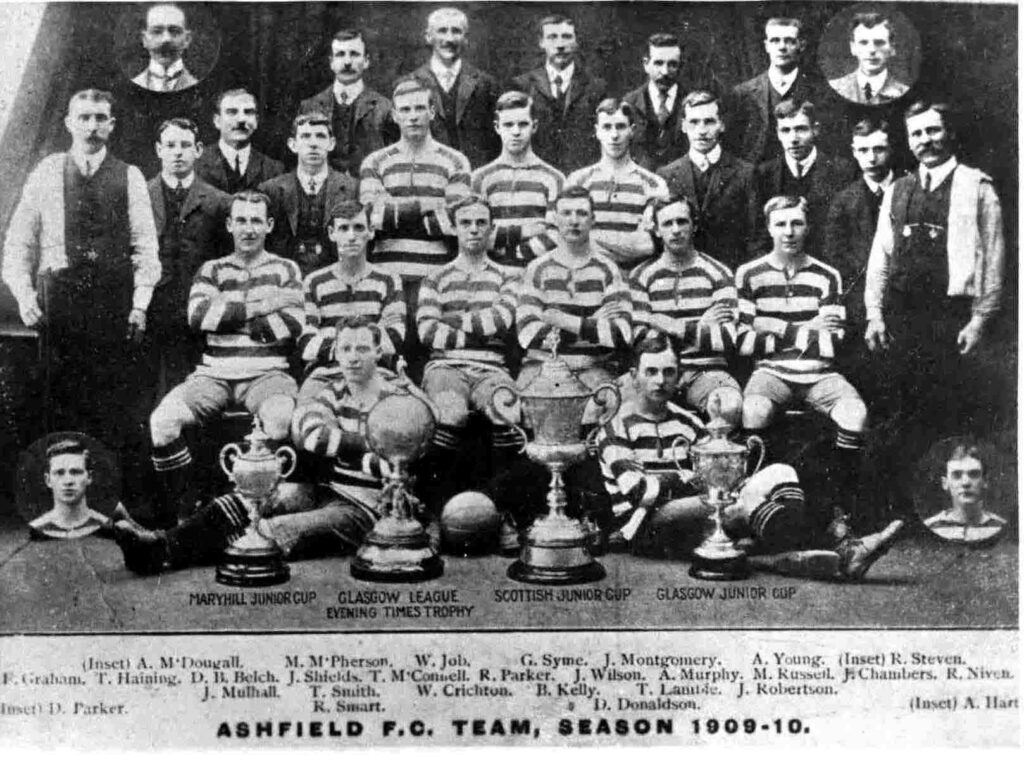
(photo: Ashfield-FC)
A March 1910 report in the Daily Record hailed Bobby’s hat-trick-scoring performance against Benburb in the semi-final of the Glasgow Challenge Cup, at Atlas Park, Springburn as ‘magnificent.’ The following month, the Edinburgh Evening News featured a profile of ‘Bobbie’ (sometimes his name was spelt this way) in which it described the ‘Ashfield Star Man’ as ‘a player for the first order,’ the ‘crack centre’ in Scottish junior football and the possessor of ‘fine footwork’ and ‘brilliant shooting’ which was gathering a host of admirers. This was prescient, as clubs in senior league football were being spurred into action, lest they miss out on such a precocious talent. Indeed, many players from the Ashfield team were destined to migrate to Senior clubs.
The coveted forward had seemed destined for Third Lanark. Aware of Bobby’s burgeoning reputation at Ashfield, their manager, Mr. Tarbat, invited him for trial at Cathkin Park. After a successful match he was invited up to the director’s room to sign on the dotted line. However, with the pen in his hand and ready to apply his name to the paperwork, he froze. Overcome with panic, he repeatedly exclaimed: ‘I don’t want to sign,’ before making a swift exit. Had Third Lanark waited a while to let Bobby decompress after the match they may well have got their man.
Instead, it would be Scottish football giant Rangers who acquired the prolific Possilpark man’s services in the summer of 1910, club secretary William Wilton sealing the transfer. The Scottish Referee, dated 29 August eulogised:
The Ashfield centre of last year was, without doubt, one of the most popular players who ever performed in the ranks of a Glasgow junior club, and Rangers are to be congratulated on the possession of such a capable reserve. Being still in his teens, he is perhaps yet young enough to be entrusted with the responsible position of a senior centre-forward, but he can easily afford to wait a little, and profit from the experience he is bound to get, even in the A team.
The publication was accurate in its prediction that Bobby, after debuting in a pre-season benefit match at Firhill for a Partick Thistle player, would need patience when it came to first team opportunities. For his prospects of progression at Ibrox were blocked by the brilliance of incumbent centre-forward Willie Reid who, as at the time of writing remains the fourth top goal scorer of all time in the Scottish top flight.
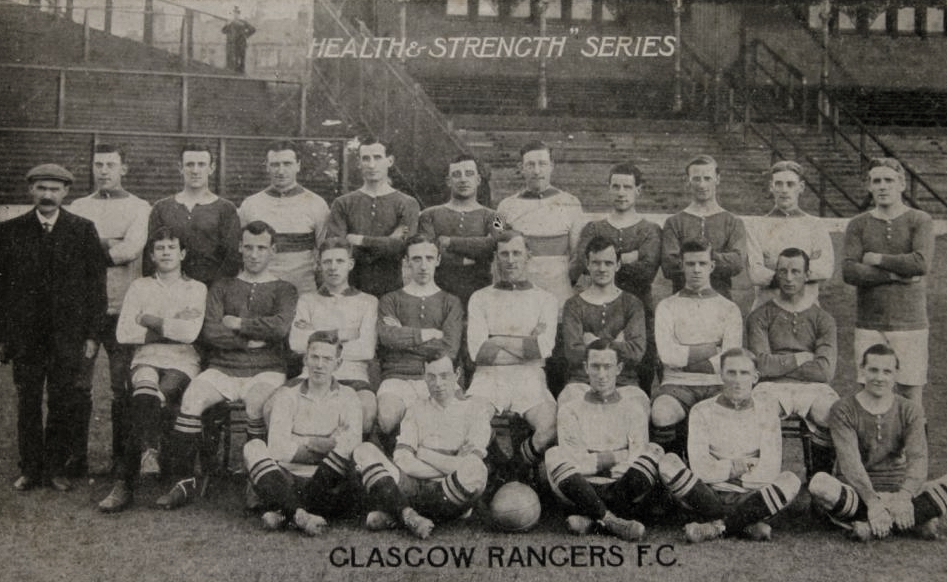
Bobby second row, second from right
After briefly being tried alongside Reid early in the 1910/11 season, Bobby was consigned to the reserves, and only made one further appearance, as the champions elect defeated Queens Park on 18 March 1911 – a match in which Bobby got off the mark for the Ibrox denizens. Although Rangers were crowned champions, Bobby did not meet the appearance criteria to receive a winner’s medal. It was much the same story in 1911/12 – the understudy to Reid making a modest three starts, scoring two goals, as the Gers retained the league trophy. The following season offered more opportunities, due to injury to Reid, Bobby scoring nine times in 12 appearances (enough to earn him a champions medal this time). However, when Reid was fit, he was in the side – and Bobby was out in the cold.
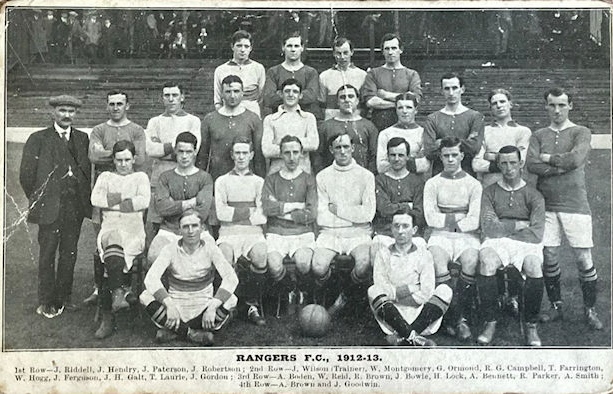
Playing second fiddle, seemingly in perpetuity, frustrated Bobby. Clubs cognisant of the reserve striker’s promise but limited Rangers opportunities, beat a path to Ibrox. Blackburn Rovers and Newcastle United were in the hunt, as was Everton FC, who had been on the lookout for a central striker to follow in the tradition of Fred Geary, Sandy Young and Bertie Freeman, the latter arguably sold too soon, aged just 26, in 1911.
George Beare, Frank Bradshaw, Tommy Fleetwood, Tom Page and Tommy Browell were amongst those to fulfill the attacking pivot role for the Toffees, with varying degrees of success. The Everton board minute books reveal that as far back as March 1912, club secretary Will Cuff was dispatched to Glasgow to run the rule over Rangers’ reserve forward. Nothing appears to have transpired at that point,
The surprise sale of Tommy Browell, who had scored 37 times in 60 Everton appearances, to Manchester City in October 1913 made the acquisition of paramount importance. Weeks later, the Toffees were rebuffed in their attempts to sign Airdrieonians’ centre-forward James Reid (who would go on to be capped by Scotland three times), so attention swiftly turned back to Bobby. Cuff wrote to Ibrox, asking after their second-string striker’s availability – offering William Stevenson in part exchange. Rangers did not dismiss the approach out of hand, instead giving an indication that they might do business if former Greenock Morton man John Fulton could be a makeweight in a deal. Rangers stated that they’d expect £1000 in addition to Fulton, should they be convinced that the left-sided defender could also operate at right-back.
Officials from the Glasgow club were invited to come and watch Fulton play that next weekend, while Cuff and director Andrew Coffey headed north to see Parker in action, with powers to negotiate the transfer deal. Rangers subsequently agreed in principle to a deal of Fulton plus £500, and everything rested on Parker, who was less than keen to move south and elected to attend the next board meeting before making a decision. Everton made sure that they were also present in the Ibrox boardroom to push things through.

(The Everton Collection)
Mid-way through the Toffees’ emergency board meeting on 27 November, Will Cuff entered the room at the Bradford Hotel with the news that Parker’s services had been secured on a wage of £4 per week plus a £10 bonus. The net outlay by the Merseysiders was £800, with the Rangers forward valued at £1,500 and the Everton reserve full-back priced at £700.
Announcing the deal, the Dundee Evening Telegraph heralded the signing as a triumph for the Toffees:
In Parker Everton have made a great capture. Indeed, to many he has for some time been regarded as a superior centre to Reid, but the latter’s goal-scoring consistency has been such that the understudy got few opportunities of displaying his real worth in first class football.
The similarly approving Liverpool Courier referred to the signing as a ‘clever centre forward blessed with a splendid shot’.
Having tied up his affairs in Glasgow, Bobby alighted the train to Liverpool on 3 December. Most likely he was initially lodged in digs close to Goodison Park under the care of a live-in landlady or landlord. In time, he would reside at 22 Coningsby Road, a turn-of-the-century terraced house with bay windows, the proverbial stone’s throw from Stanley Park and the Anfield stadium. Having unpacked his bags and met his clubmates, he went straight into the first team for the visit of The Wednesday. His arrival on Merseyside was somewhat overshadowed by the acquisition of goalkeeper Tom Fern from Lincoln City – both would play a significant role in success to come at Goodison Park.

Getting off the mark with a debut winning goal was not enough to impress the Liverpool Courier correspondent, who gave this lukewarm analysis of the new Blues striker:
Parker, Everton’s new centre-forward, had the honour of securing the only goal for his side, but like other Scottish players who have come to Everton, he was not quick enough at times. It would be unfair to judge him by his first turnout, and he certainly had a tremendous obstacle in McSkimming, the Sheffield centre-half. He did secure a goal, and that was more than any of the others could do.
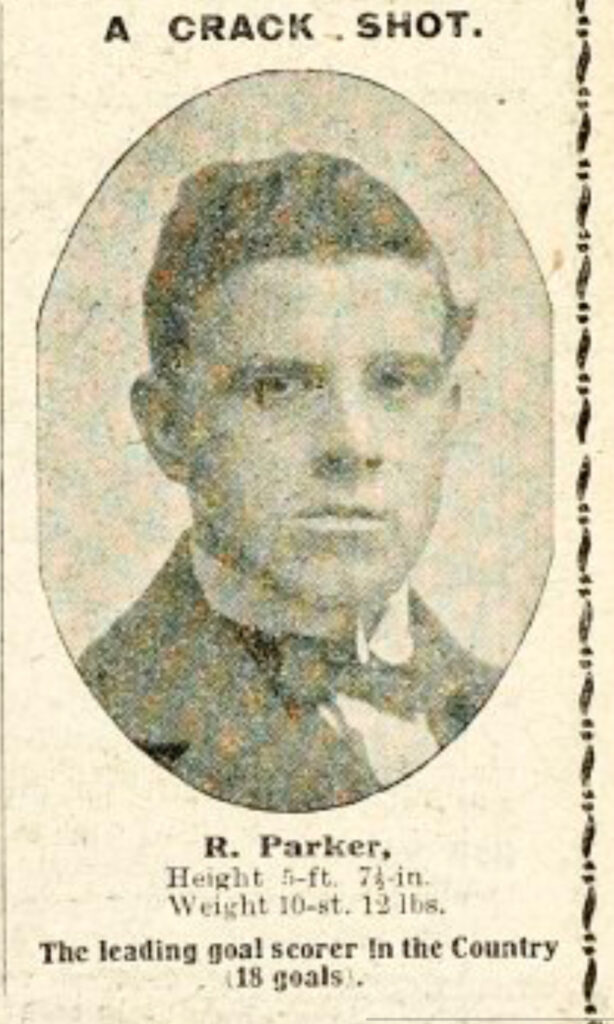
Athletic News was somewhat more generous with its praise for the debutant:
Parker is well equipped physically for the onerous post which he has agreed to occupy, and on his first appearance in English League football he created a decidedly favorable impression. He controlled the ball well, passed judiciously, and gave many signs of efficiency, when once acquainted with his new comrades. A further report in the same publication stated: ‘Parker was pleasing. Right at the start he made friends by his pretty and paying passes to the inside forwards, but he varied his service by plying the wing men, and especially Harrison, with some choice ground glides at a nice oblique angle. One such example to Beare evoked a cheer, for the ring was keen to appreciate his merit. His passes were delightful, but he did not shoot so well as I expected.
In truth, the Scot needed some time to adapt to the English style of the game. After a mixed first few weeks, Bobby hit his stride over the festive period. He scored the winning goal at Old Trafford on Christmas Day and showed this was no fluke by netting a hat-trick in Boxing Day demolition of the same opponents at Goodison Park. The Liverpool Courier, once critical of the marksman, was now effusive:
PARKER’S FINE DISPLAY.
There was no better player on the field than Parker. He played magnificent football. His long passes to the wings were always well judged and accurately placed, and he was always alert for openings. Beare, and Jefferis were also seen to better advantage than in the Chelsea match, and although Beare often found Stacey too quick for him, he did some good work.
Twelve more goals followed that season, including four braces. These proved vital as the Blues finished the season equal with Liverpool on 35 points, just five above the relegation zone.
Holidaying back home in Scotland for the summer, and spending much of his leisure time with former Rangers teammates, he confirmed to the Scottish Referee that he found football in England much more strenuous with more running around required, but that he was coming to terms with it, and felt that he would play better in the season to come. The Possilpark man would soon be joined by former Ibrox clubmate Jimmy Galt – a half-back who had earned two Scotland caps. The Everton side would also feature quality players like the aforementioned Tom Fern and Tommy Fleetwood, plus promising winger Sam Chedgzoy and Frank Jefferis, a twice capped inside-forward. That said, it was not a team of stars and, based on the previous season’s results, there was only limited cause for optimism amongst the Goodison faithful.
Galt made a big impression in pre-season and was swiftly appointed captain – his importance to the season to come cannot be overestimated. A Daily Record and Mail ‘pen pic’ profile from 1923 underlines his approach. The new skipper arranged a dinner with colleagues at which a campaign plan for 1914/15 was agreed. These talks became a weekly occurrence as the season progressed. Galt would find the weaknesses and strong points of opposing teams before playing them and hatch a plan. Prior to the visit of Sunderland to Goodison in November, the captain ascertained that the Rokerites centre-half Charley Thomson was almost impossible to get past. So, he hatched a plan to lure him out of position and punish the opposition. ‘You’ll keep the ball on the image for twenty minutes. Bobby Parker can wait.’ was Galt’s, order. Sure enough, Thomson got dragged out of position in order to get involved in the action, and, with that, Galt issued the command: ‘Now’s the time’ let it go up the middle.’ Bobby, with a clear path to goal, duly scored a hat trick in a 7-1 win.
As was the tradition, the season was preceded by a couple of practice matches between the nominal first eleven (‘The Blues’) and the expected second string (‘The Stripes’). Bobby made a clear statement of intent when bagging three for the Blues in their 5-1 victory. Joe Clennell, with whom Bobby would dovetail beautifully in the season to come, grabbed a brace.
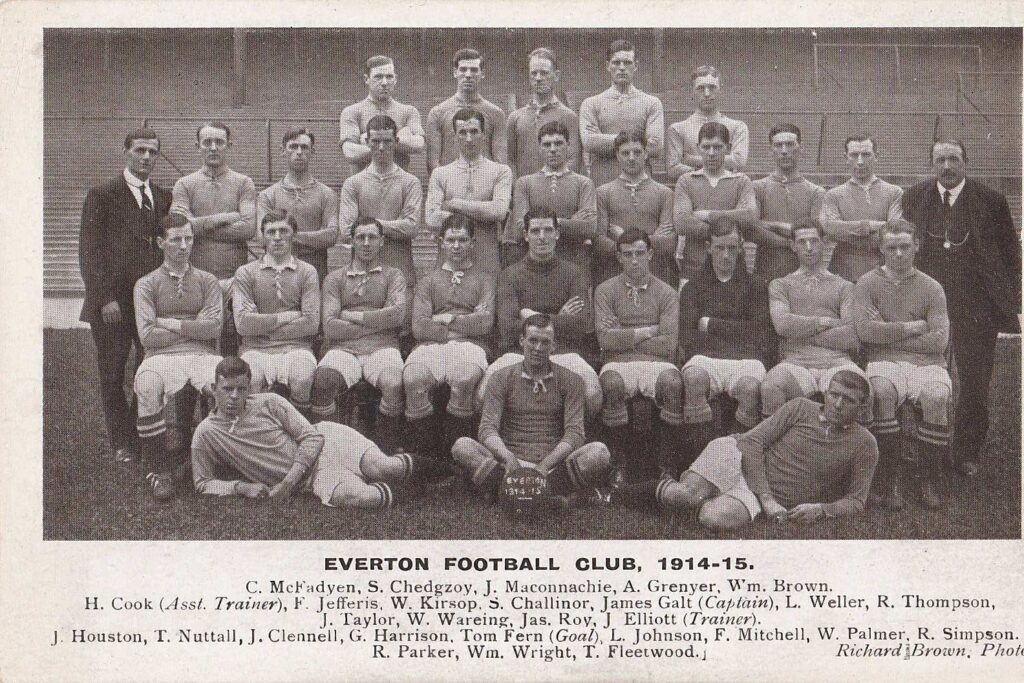
When the season got underway with a midweek defeat of Tottenham Hotspur on 2 September, Britain had declared war on Germany four weeks previously – the disastrous result of the domino effect of international alliances after the assassination of Archduke Franz Ferdinand in Sarajevo on 28 June. With many young men enlisting for the armed forces or entering war work on the home front, the concept of footballers continuing to earn a living playing sport was looked upon with distaste by many, but the Football League argued that regular football would boost morale.
Over the festive season players and spectators were invited to complete survey cards under the Lord Derby football census scheme. After some nagging by Lord Derby, of the Everton squad, the following indicated their willingness to join the army when called upon to do so: Makepeace, Parker, Galt, Fern, Mitchell, Chedgzoy, Nuttall, Houston, Weller, Johnson, and Roy (seven Liverpool players did likewise).
On the pitch, fortunes had been mixed in early season, including a run of three consecutive defeats, but a thumping 5-0 defeat of Liverpool at Anfield on 3 October seemed to transform the outlook. There were many army trainees in the crowd in their khaki fatigues, and one ‘Tommy’ walked around the perimeter of the pitch with a sandwich board, encouraging people to enlist; recruiting officers were on hand to collect signatures. The soldiers – and future soldiers – watched a glorious afternoon for Bobby. He smashed the ball past Campbell on 35 minutes to put the visitors two goals up. In the second half he would claim a hat-trick through a spot kick and a glorious late first strike from distance when released by a Galt pass.
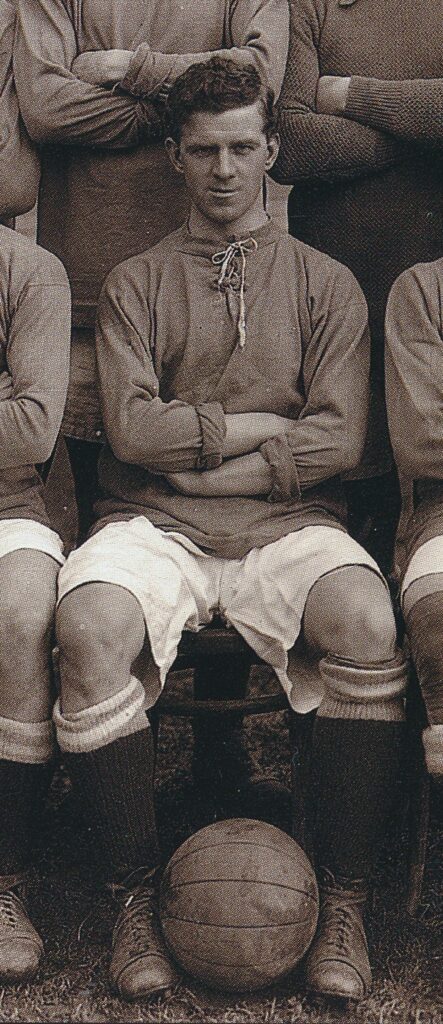
A purple patch in November and December saw Bobby hit eleven in four matches, as the Blues swept all standing in their way. A hat-trick in a 7-1 drubbing of Sunderland was followed by all four Everton goals at Hillsborough. Next up was a 2-1 home defeat of West Bromwich Albion, Bobby contributing one goal before he claimed another hat trick in a 4-1 win over Manchester City, taking him to the 21-goal mark. The Liverpool Echo correspondent, predicting that the Blues might now be considered as title contenders, picked out Bobby as the star man. ‘I hope and believe Parker will pass the record score [38 goals scored by Bertie Freeman in 1908/09], for he is shooting dead on the target, and his dribbles in zig-zag fashion to goal are beating more than one set of defenders.’
The striker’s form did not go unnoticed north of the border. The Scottish Referee commented on 2 November: Everton have now found out what a goal-scoring centre-forward means – and Bobby Parker is improving every week and looks like having a record season before him, bar accidents. This was not enough to entice the SFA to cap Bobby, his status as an ‘Anglo’ counting against him.
Fame can attract grifters and it was no different over a century ago. The Liverpool Echo’s sports editor Ernest Edwards (pen name Bee)warned readers of a Parker impersonator who bore a striking resemblance, albeit being a bit shorter than the real McCoy. The desperate doppelganger was, according to Bee: ‘Dodging landladies for rent and food, and altogether has worked the trick very well for some time. He shows sound judgement, that’s certain, for it appears that he has always quoted “Bee’s Notes” when he is trying his game on. He never, it is said, attempts anything further than the points mentioned in my notes. Well, well, what a life we actors lead! Landladies and others should be very chary in future with anyone pretending to be Parker.’ Jimmy Dunn, Bobby’s compatriot who starred alongside Dixie Dean at Goodison in the 1930s, had a similar experience at the height of his fame.
He would increase his goal tally, albeit at a slower pace than in the autumn, before exploding into hat-trick form again on 10 February in a 5-1 away defeat of Aston Villa. Although in the top group of clubs for much of the season, briefly climbing to second place early in January, the Toffees were inconsistent, as marked by two defeats within four days, first at Ewood Park, then losing by the odd goal in seven to Oldham Athletic at Goodison Park. This put the Boundary Park club clear at the top, with three matches in hand on their nearest rivals – with a first league title almost within grasp. Bobby would have had mixed emotions, for in defeat he scored two of his finest goals of the season – both from acute angles – drawing praise from teammates, opponents and former players in the stands, as described in this Evening Express match report by someone using the byline The Critic:
The centre forward has not been in the picture a great deal lately, but he brought his total of goals to 28 yesterday. He dashed round the backs and drove the ball on each occasion from a most difficult angle. The shots were superb and were decidedly the best of the match. The players on the stand – one noticed old favourites in Jack Taylor and Billy Stevenson among the present Everton and Liverpool players. Notably, Galt applauded Parker’s second point, and it was noticed that Wilson, the Oldham half-back ‘patted’ Parker on the back as he walked up the field.
One factor in the Blues’ mixed fortunes in the New Year had been the loss of Frank Jefferis to a knee injury on Christmas Day, with local lad Billy Kirsopp deputising at inside-right for the second half of the campaign. Although being a first team novice, Kirsopp let no-one down, netting nine times in sixteen appearances.
Although the Blues bounced back, scoring nine goals in two home wins (Bobby contributing four), consecutive home defeats on Good Friday and Easter Saturday, without a goal being registered by the Blues dropped them to fifth place. Although Oldham Athletic remained in the box seat, Blackburn Rovers and Manchester City were in the mix. The Evening Express after the defeat to The Wednesday, proclaimed: ‘Everton’s Downfall: Everton said “good-bye” to the championship on Saturday.’
Ernest Edwards, writing as ‘Bee’ in the Echo, had his theories on why Everton had apparently blown their gilt-edged opportunity to claim only a second league title:
In addition, some of the men who have played have been unfit. Take Parker, for instance. He’s been hard at it for some time and has been buffeted about. At Aston he hurt his knee; and searching for some idea of his falling-off leads one to the conclusion that he needs a rest and then would come out fresh as paint again.
And then, unexpectedly, the Blues and Bobby found their mojo, beginning with a convincing 3-0 victory at Roker Park. Already a goal up through Kirsopp, the Toffees were home and dry through a superb long-range effort from their free-scoring Scottish centre-forward, followed by a perfectly taken goal for his brace. Not only was his unerring when taking aim, according to Bee there was fantastic link up play in his game: ‘As a pivot Parker fed his wings with marked success, and gave them opportunities of which on the whole, commendable advantage was taken.’
Bobby missed the next two matches through illness but, without him, his clubmates secured priceless narrow wins on the road at The Hawthorns and Bradford Park Avenue. The latter was a replayed fixture after the first attempt had been abandoned in arctic conditions in February – luck was on the Toffees’ side as they had been trailing the Yorkshiremen 0-3 at the time the referee called a halt to proceedings. Next up were fellow title challengers Manchester City at Hyde Road. Against a parsimonious Mancunian defence, Bobby surprised the goalkeeper with a sharp shot and Joe Clennell was on hand to bundle the ball over the line from the rebound. That was enough to earn a hard-fought victory.
The four consecutive Toffees wins on the road may have narrowed the gap on Oldham, but their rivals had reached 45 points, two clear of Everton with two matches to play, after two wins and two drawn two matches. All the mill town club needed to secure its first Football League Championship was to win the final two home matches of the season, against Lancastrian rivals Burnley and Liverpool. As it transpired, a 2-1 defeat to the Clarets piled on the pressure in anticipation of the crucial visit of the Mersey Reds.
The Toffees held an advantage in that their final fixture had been pushed back to the Monday, as their opponents Chelsea were taking part in the FA Cup Final on the Saturday. Thus, Everton would know exactly what was required of them before their match against the Pensioners kicked off. Chelsea had defeated Everton in the semi final of the cup in late March, the Toffees hampered by the loss of Harry Makepeace to injury just 20 minutes into the match.
Liverpool’s 2-0 defeat of Oldham on the Saturday effectively confirmed the Toffees as League Champions on goal average. As it panned out, Everton ended the campaign by sharing the points with the Pensioners – a 2-2 draw – to win an amazingly tight title race by one point. Remarkably, Everton had not sat in first place in the division until the last weekend of the competition – the Toffees had done a late run on the rails while, to their chagrin, the Latics had done a Devon Loch.
Bobby rounded off a highly successful campaign with one of his finest goals. Bee, reported on it for the Liverpool Echo:
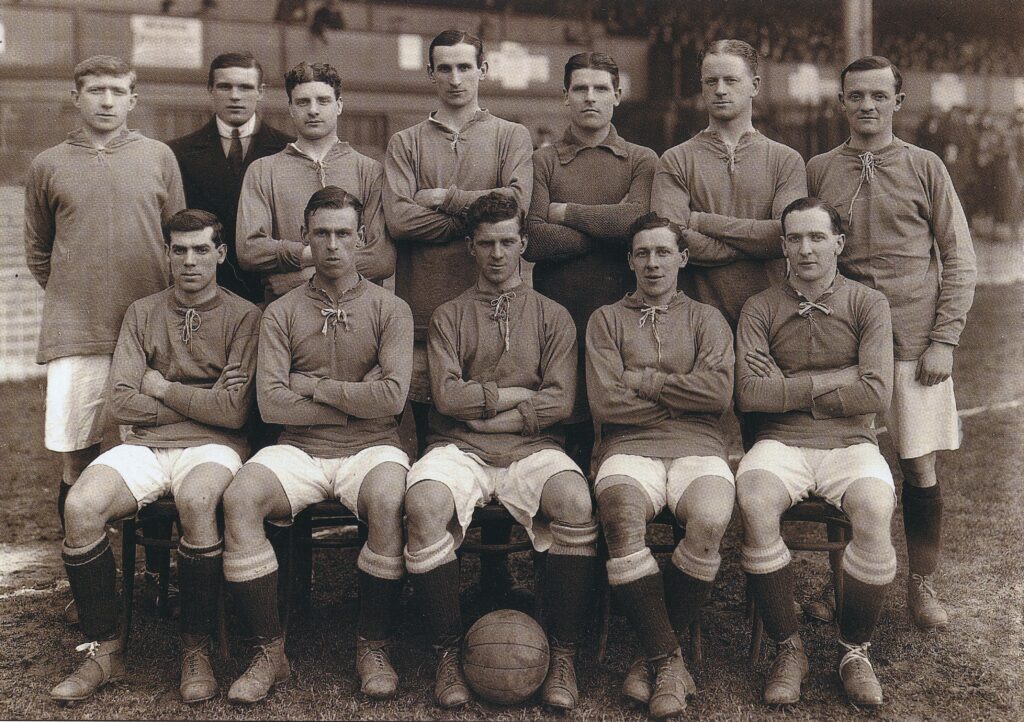
The best goal of the day was Parker’s, and it was worthy of a place beside that memorable goal scored by the centre against Oldham Athletic. A corner of strength -as Harrison’s corners generally are promised to turn outside at a wide stretch. Now, Parker had not his face towards Molyneux. The ball was travelling speedily and at a high level. Parker tried to hook the ball, timed his impact right, and sent the ball scudding over the goal-line at a very fast pace. It was a wonderful book, as will be recognised when I tell those not present at the game that Parker had to ‘press’ his leg so far that he fell full length so soon as he had touched the ball. There was a chanciness about the shot, that’s sure, but there could be no doubt about the brilliance of the goal once Parker had got his foot against the ball.
Only 10,000 were present to witness the coronation. Indeed, Goodison Park had only hit the 30,000-spectator mark through its turnstiles on one occasion all season. That was for the Merseyside derby – a sure sign of the impact of the unfolding hostilities in Europe.
Bobby ended the season on 37 goals (35 league goals in 25 appearances, plus two cup goals in five appearances), coming up just one short of Bertie Freeman’s club record in league matches. The directorate decided to source 13 League winner’s medals for the players with the highest number of appearances during the triumphant season. They also authorised merit payments which varied based on appearances. Bobby pocketed £37 to go with his coveted medal.

Days later the newly-crowned champions rounded off the season with the Birkenhead Borough Hospital Cup match at Prenton Park – a strong Everton side beating the hosts 5-3, with Bobby on target twice.
Thomas Keates, Everton’s first official biographer (author of the club’s golden jubilee history in 1928/29), wrote: ‘As the goal scoring indicates, Parker, Clennell and Kirsopp were the most effective in the front rank. Fairly free from injuries, and the resultant changes they involve, the combination was admirable, the accurate passing methodic, and the attack dashing.’
There was little in the way of celebration for the Toffees as war raged. Even the Liverpool Echo, usually a champion of the two Merseyside footballing rivals, struggled to muster much enthusiasm for Everton’s title triumph. The pages of the paper in the days that followed were, instead, dominated by drawings of the battle front at Ypres and speculation about a further offensive action in the Dardanelles.
Against this backdrop of a bloodthirsty war with no end in sight, it became an inevitability that there would be no regular football competitions in the 1915/16 season. Consequently, players’ contracts would end on 31 May, with some enlisting in the armed forces and others seeking employment in war work on the home front. In August, pulling in some favours, it seems, Bobby had obtained employment in a shell manufacturing plant in Glasgow’s Cathcart district. He notified Everton of this and indicated that he would seek to turn out for a club in that city – with Queens Park cited as his probable destination, should clearance be obtained from the football authorities to turn out as an amateur.
In England, two regional leagues were formed, with the Toffees competing in the Lancashire Section., along with Liverpool, Stockport, Burnley, Manchester United, Manchester City, Stockport County and others. Everton giving their blessing was not enough to persuade the authorities to permit Bobby’s to change his status and play for Queens Park. Instead, he made himself available for his parent club, getting back into action on 23 October. He picked up where he had left off in April – notching a hat-trick in a 4-2 defeat of Manchester City. The intermittent appearances dried up in mid-January 1915, having scored six goals in seven matches. This would be the sum total of wartime appearances for his parent club, and he would not pull on the royal blue jersey again for a month shy of four years.
Back working and living in Scotland, Bobby would make one guest appearance for his former club, Rangers and regularly assisted Greenock Morton during the 1916/17 season. Working in armaments manufacture served to delay Bobby joining up, but by late September 1916 it was announced that he had joined the Royal Scots Fusiliers as
Private 361330 Robert Parker – most likely in a Reserve Battalion, based in Britain. We can only speculate if his enrolment was linked to the death of his brother, David, who had also played football for Ashfield. Serving as a sergeant with the 16th Battalion, HLI (2nd Glasgow), on 8 April 1916 David succumbed to wounds suffered on the Somme battlefield. David was laid to rest at Villers-Bocage, north of Amiens.


Bobby was subsequently stationed in South Yorkshire, and was reported to be possibly turning out for Rotherham as a guest player. When mobilised and then posted to Egypt, it is most likely he was with the 1/4th Royal Scots Fusiliers (part of the 52nd Division).*
[*NB. The reason for the level of uncertainty is due to the fact that Bobby’s personal war record has not survived. In September 1940, as the result of a fire caused by an incendiary bomb at the War Office Record Store in Arnside Street, London, approximately two thirds of 6.5 million soldiers’ documents for the First World War were destroyed. Those records which survived were mostly charred or water damaged and became known as the ‘burnt documents’.]

Liverpool Echo, 22 February 1917
From their base in Egypt he wrote to Jack Elliott, the Everton team trainer, and informed him that football was becoming very popular ‘in the land of the pharaohs,’ ending with ‘Have no fears concerning the future of the game.’ Post war, he reflected on his time in Egypt and Palestine for the Sunday Post. Cognisant of football becoming the national form of recreation, he made a light-hearted – but as it has turned out, a century on, amazingly prescient prediction:
Would it not be quaint to hear of some of our famous players in days to come emigrating to the East to figure in the Jerusalem League, or Nile Valley Combination, or perhaps some of them ‘going to Jericho.’ Sounds really funny, does it not? And yet they are hot football out there. The attendances at the military matches showed that the natives actually paid to get in, and they don’t give anything for nothing in these countries.
Among the football men he came across while posted abroad were Georgie Livingstone, Mc Dougal (Liverpool and Falkirk), Murray (Everton and Patrick Thistle), Strachan (Woolwich Arsenal) and John Cuffe, the former Glossop player, who was by then attached to Ayr United.

Just over a year after David’s death, further misfortune would befall the Parker family when, Bobby received significant wounds in action. The fog of war and lack of surviving records has made it hard to establish the full facts of where, how and to what extend Bobby was wounded. It is unsurprising that, in the information vacuum, several myths have evolved.
As to the when and the where, Bobby’s injuries were first reported in the British press on 13 May 1917. It is reasonable to deduce that he was wounded in the fortnight preceding that, but we cannot be more precise. This makes establishing the location equally problematic. A reasonable educated guess would be the Second Battle of Gaza, where British troops suffered heavily at the hands of Ottoman forces bolstered by German support.


With regard to the wounds sustained, Bobby’s British Army pension records make reference to a gunshot wound (or wounds) – GSW for short – to his abdomen. Maybe this contributed to the oft-reported story of Bobby having a bullet lodged in his back for the rest of his life. However, the term GSW was a term used as shorthand in such documents for injuries resulting from a variety of projectiles, including bullets and shrapnel from shells. The latter would be the most likely – we know, from a letter Bobby sent to Will Cuff at Everton, that he had undergone surgery in a hospital in Egypt to have the foreign bodies – probably eight pieces – removed.


Bobby’s pension records also make reference to his war injuries having a 30% impact on his physical abilities. Whether that percentage is measured against the ‘man in the street’ or a professional footballer’s normal level of agility, is not clear. Although his later infirmity was often attributed to the unfortunate events of May 1917, there was a far clearer cause, which will be covered further down this article.


Whatever the cause of the wounds, they were serious enough to require no less than three months of bed rest after the surgery. The nature of reporting restrictions and the innate tendency to downplay bad news, makes it hard to determine more. Bulletins printed in newspapers after the news of his wounds first broke pointed to him ‘doing well.’ In mid-June, the reports from Cairo carried the encouraging news that he was ‘progressing favourably.’ This was corroborated by Bobby informing Will Cuff by letter that the wounds were healing ‘splendidly,’ adding that the doctors believed that he would soon be well again and ‘fit for football as before.’ Again, the above have to be looked at through the prism of wartime reporting restrictions and censorship of letters.
The 42nd Division of the Royal Scots Fusiliers moved on to France in the spring of 1918. Bobby was still in Alexandria, recuperating, and never saw action on the Western Front – a blessing in disguise for the badly wounded footballer. In February 1917, the Scottish Command had formed several companies of Labour Corps, and it is likely that Bobby had already been posted to one of them as Private 203350 Robert Parker Labour Corps, by the time the Fusiliers left for France in April 1918.

Liverpool Echo, 14 August 1918
In mid-August 1918, Everton full-back Louis Weller wrote to the Echo’s Bee – and relayed some positive news from Egypt: ‘Yesterday I received a letter from old clubmate, Bobby Parker, who is at Alexandria. He has fully recovered from his wounds, has played a few and is having a rest from it, but thinks he will be fit when once in old Blighty.’ George Tate, a footballer from Wick who had represented Second Division Abercron FC would, in the John O’Groat Journal, recall figuring in the same Scottish XI as Bobby when taking on an English XI in a military international in Egypt in 1919.
Thomas Keates, in his official history of Everton FC, had written that ‘Mars had been kind to our players.’ It was correct that no first-teamers had been killed in action (several former players and non first-teamers had not been so fortunate), but Keates’ statement overlooked Bobby’s physical injuries and the PTSD suffered by James Galt. The club skipper would not play football at a high level again.
The Everton man returned to Albion at some point in 1919. Along with Chedgzoy, Harrison and Kirsopp, he was not demobilized before the Football League programme recommenced after a four-year hiatus. Bobby was finally back on civvy street on 29 September (he received the British War Medal and the Victory Medal in recognition of his service) and then had to work his way towards to the fitness levels required of a top flight professional footballer. He attended Rangers’ match at Ibrox on 18 October, and was described in the Daily Record and Mail as being ‘almost himself again’ and on the point of returning to Merseyside.


In mid-November he travelled from Liverpool to Scotland to report on an Ayr United versus Celtic match for the Sunday Post. He may have been keen to accept the reporting mission as it was in the ‘Auld Toon’ (as he described it in his article) where he had received his training with the Royal Scots Fusiliers. While in Scotland, a Dundee Evening Telegraph snippet described him as looking ‘fit and well but thinner than of yore,’ which should have come as no shock after his traumatic wartime experiences.

Bizarrely, Bobby’s comeback for the Everton reserve team – a match against Manchester City – was played on Christmas Day. The Scot was immediately on the goal trail, getting the Royal Blues’ goal in a 1-1 draw. Two days later he returned to first team action after a gap of four-and-a-half years – in a Merseyside derby, no less.
Although scoring neatly from a Sam Chedgzoy corner, Bobby appeared, unsurprisingly, to be some way off the pace. The Liverpool Daily Post and Mercury assessment was blunt: ‘Parker, who made his initial appearance in the League team, was hardly a success.’ He was reportedly slow, and missed a penalty kick in his next match, against lowly placed Sheffield Wednesday.
Louis T. Kelly (father of the future Everton secretary, Theo), writing his ‘Stud Marks’ column in the Football Echo, took a more rounded and compassionate stance than the Daily Post: ‘For a man so severely wounded as was Bobby Parker in the war, the amazing thing is that he has been able to play any sort of serious football so soon.’
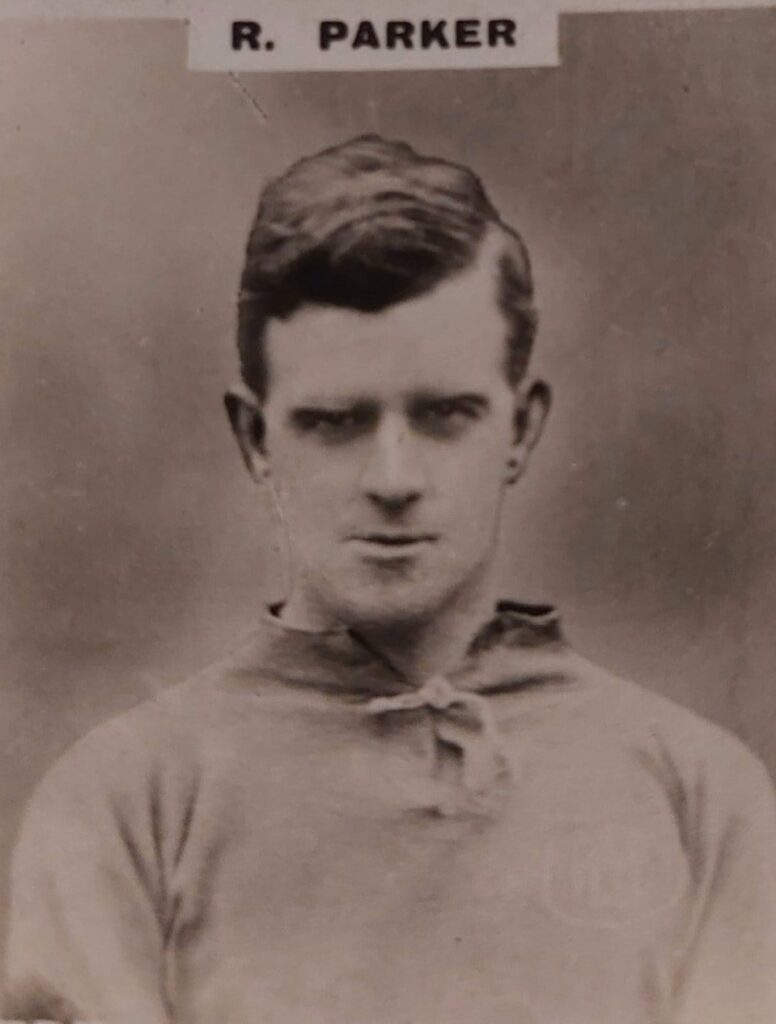
There were signs of the old Parker form in late January, when Bobby grabbed a brace against Newcastle, described thus in the Liverpool Courier: ‘Parker obtained the other two in the second half, with furious drives taken on the run, splendid goals each of them and models of opportunism.’ He followed this up with a goal against Aston Villa in the next match. However, he was dropped after a heavy away defeat to Newcastle United and only made two more appearances that season, failing to register a goal in either.
He started the 1920/21 season with a bang, netting twice in a 3-3 draw at Bradford Park Avenue. Dropped in the autumn, he showed goalscoring form when back in the team throughout December and January, but his brace against Manchester United on 12 February would turn out to be his last goals and penultimate appearance as a first teamer. He signed off in a 0-2 defeat to Tottenham Hotspur in mid-March. The Liverpool Daily Post and Mercury pulled no punches when describing a blunt Blues forward line: ‘The attack indeed, was disappointing and rarely dangerous. Parker missed many fine chances offered to him by both Harrison and Clennell.’
Thus, Bobby saw out his Everton career, which burned so brightly in 1914/15, with something of a whimper by turning out for the reserves. Just about to turn thirty, the consensus was that Bobby had lost the fabled yard of pace that a top striker required – whether this was due to the war-enforced pause in his playing career, the lasting effects of war wounds or merely the passage of time (or a combination of the above), it is now hard to conclude.
Made available for transfer by the club for a £1,000 asking price he was not without suitors; a London club was reportedly interested while Partick Thistle and Ayr were also in the reckoning. When Everton considered signing Clydebank’s inside-left Harold Paton, the Toffees had it in mind to include Bobby as the makeweight in the proposed deal. Bobby was back in Glasgow, at the home of his parents at 218 Saracen Street when the 1921 Scottish census was taken on 19 June. He listed his occupation as a professional footballer with Nottingham Forest. That would soon change, however.
The in-demand striker travelled to Pittodrie for a meeting with the Aberdeen manager, and seemed set for a move to the North East coast. Then, having had a £500 bid accepted by Everton, Nottingham Forest sent a deputation to meet the forward in Glasgow and persuade him to throw in his lot with the Second Division side. With the ink drying on the transfer papers, Bobby headed off for a holiday in France before starting a footballing sojourn in the East Midlands. He left Goodison with little fanfare, the Echo briefly noted: ‘We understand Bobby Parker has signed for Nottingham Forest.’
In Garibaldi red Bobby enjoyed regular football again. He scored on his home debut, against Hull City, and found some of his old form, if not being as prolific as in his pomp. Following a superb 4-0 away win at Hillsborough in February 1922, the Nottingham Journal hailed the Reds as ‘Bobby Parker’s Dazzlers’ and highlighted his ‘great leadership’ when up against Wednesday’s England international centre-half. Of Bobby, it proclaimed: ‘There was no more prominent player on the field.’

A fortnight after the win in South Yorkshire, Bobby played his part in a piece of soccer history when appearing in an FA Cup tie in Cardiff. In doing so, Forest became the first and only team to play in FA Cup fixtures in England, Scotland, Ireland and Wales. He ended the season with nine goals in thirty-six appearances (at both centre and inside forward). He had played a significant role in the club returning to the First Division for the first time since relegation in 1911.
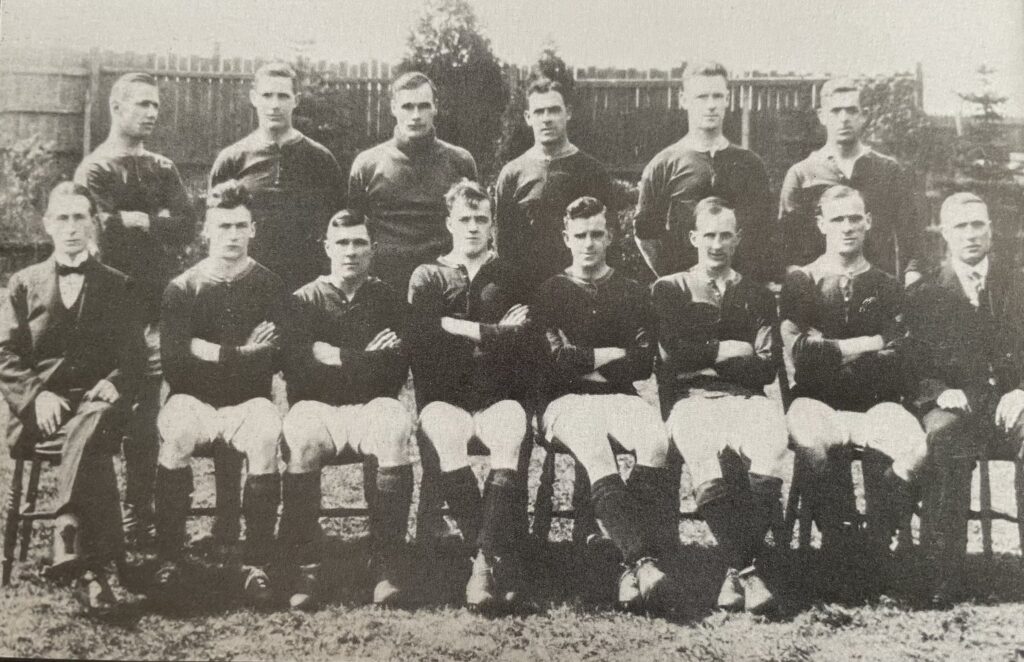
Bobby, 4th from right front row (photo: thanks to Ken Smales)
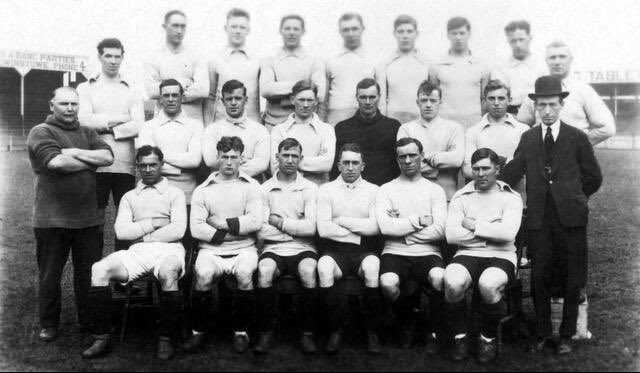
Bobby 3rd player from left, 2nd row
Having started the season leading the line for Forest in the top flight, he was dropped after five games and, after that made sporadic appearances – fifteen outings in all, contributing three goals. There was a warm reception for him given by Liverpool supporters at Anfield, who recognised a worthy adversary in blue in past seasons. His final first team selection came on 17 March at Ewood Park, but he could not mark it with a goal. For much of the season he was selected for the reserve team, competing in the Midland League side.
At this point he returned to his home city and was reportedly involved in business interests. During the war years he was mentioned in a report as being a stakeholder in a chain of Glasgow cinemas run by Everton clubmate James Galt. However, it appears that in the mid-1920s he worked in the rag trade. When he got married to Jeanie Skinner at Albert Street United Free Church on 7 March 1925, his occupation was given as a draper’s assistant. Hers was given as a tailoress, so it seems that they had met through their employment.
The newlywed ended his one-year absence from the sport he loved ended when he was taken on by Fraserburgh of the Highland League. He would lead the club’s forward line but this also marked the start of his career as a trainer-coach. To add to his burden, he was required to fulfil the club’s secretarial duties. He reportedly (as per the Fraserburgh Herald) took a great interest in the colts, with the aim of licking them into shape as future first teamers. The 34-year-old got off to a flyer for the Black and White, scoring twice for his new club in a heavy defeat of Elgin on the opening day of the season.
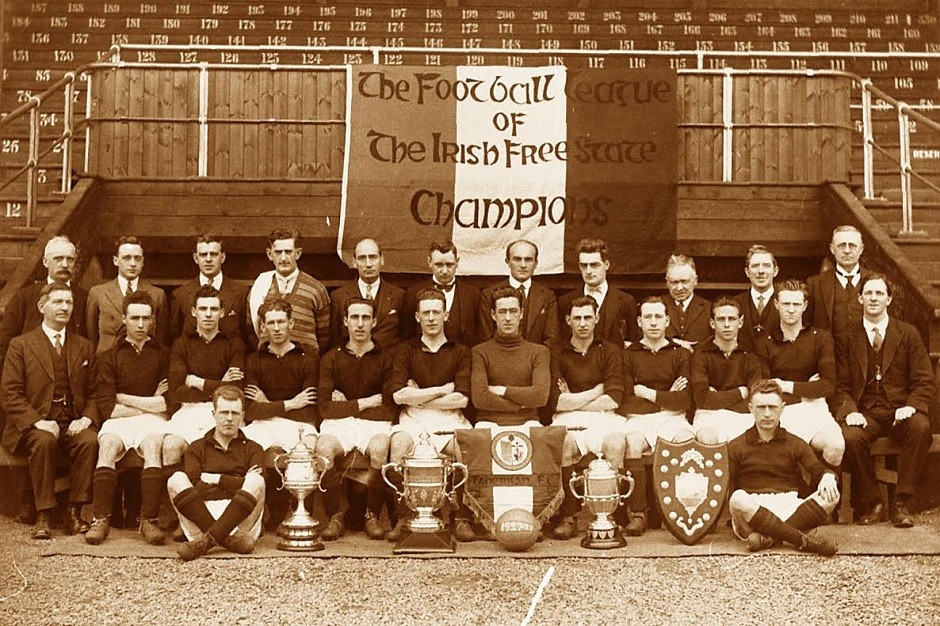
Bobby back row third from left
Come the end of the campaign, he gave notice to leave Fraserburgh and placed an advertisement in the sporting press, offering his services. It was seemingly picked up immediately by Bohemian FC, the famous Dublin amateur club, which engaged the Scot as their trainer-coach, working alongside Charlie Harris (a selection committee picked the team). The Bohs’ 1927/28 season was one for the ages. The Dalymount-based club accomplished the clean sweep of honours: winning the League of Ireland title, the FAI Cup, Shield and Leinster Senior Cup. The statistics (for all competitions) emphasise the dominance of a team which is considered one of the greatest in Bohs and Irish football history: played 36, won 29, drew 5, lost 2. Goals for 108, goals against 35. One player to benefit from the Scot’s tutelage was Christy Giles, father of Ireland and Leeds great Johnny Giles – another was teenager Peter Kavanagh, who would earn a move to Celtic.
Bobby would go on to coach the team to a further league title in 1929/30, and to victories in Belgium (the Aciéries d’Angleur tournament in 1929) and France (Tournoi de Pentecôte in 1932). His stay at Dalymount ended in the spring of 1933, but he remained in the city, having a brief spell at the now defunct Dolphin FC. In January of that year, the Everton board had instructed secretary Tom Macintosh to write to Bobby, seeking his informed views on Foley and Lynch of Cork Bohemians (the former was a goalkeeper, the latter a left-back). He wrote back with ‘fair reports’ on the pair but subsequently recommended Shamrock Rovers’ goalkeeper McCarthy over Cork’s Foley.
At this point, Bobby’s health had taken a turn for the worse. The Falkirk Herald reported in July of 1933 that the former Rangers and Everton man was ‘undergoing nerve treatment’ in Glasgow Royal Infirmary. Rather than a reference to the lasting effects of his war wounds, this was the first allusion in the public domain to Bobby living with Disseminated Sclerosis, now known as Multiple Sclerosis (MS for short), although it is unclear for how long he had had symptoms. In short, MS is a condition in which the body’s immune system mistakenly attacks the protective sheath surrounding nerve fibres in the brain and spinal cord. This disrupts nerve signals, often resulting in physical and cognitive issues. It is a chronic, progressive disease with no cure, but treatments to slow the progress of it have developed since Bobby’s era. The progression is not linear; some have long periods between attacks without any new symptoms, but others are less fortunate. The causes of MS remain unclear, although it is believed to be a genetic condition, environmental factors such as certain viral infections, smoking and stress may be contributory factors to its development. There is nothing concrete to link it to Bobby’s war injuries, however.
Bobby had almost certainly had to give up work, as his mobility was increasingly impacted, and it is likely that he was back living with Jeanie in his native Glasgow by the mid-1930s. Certainly in 1940, the couple, who had no children, were living in tenanted accommodation at 94 Morningside Street, in the city’s Cartyne district.
Bobby wrote to Everton’s secretary with a request in January 1934, but it is not clear from the board minutes what that concerned. Maybe he was alerting the club to his diminished circumstances. We do know that in September 1937, a Mr. R. R. Cochran wrote to the Toffees directorate regarding Bobby’s deteriorating financial situation. The directors agreed to send Mr. G. Evans to visit Parker when he was in Glasgow for the Scottish League versus Football League match in Glasgow on the 22nd of the month. Evans duly visited Bobby and reported back to the board. Clearly, a grim picture was painted. On hearing Evans’ report, the directors were moved to grant their stricken ex-player a donation of 10/- per week on an ongoing basis. Bobby would respond with a letter expressing his deep gratitude to his former club.
Journalist Louis T. Kelly got wind of the situation and mentioned in his Liverpool Echo column that Bobby was a sick man who had to be ‘wheeled about in an invalid chair’. Describing him as a ‘badly winged’ forward due to the war, Kelly recalled Bobby was once having been an attractive leader of the line who could hit a ball like the ‘best of them.’
Bobby Parker, successful soccer player and trainer, passed away at home on 28 December 1950. The certified causes of death were stated as a coronary thrombosis (a blood clot leading to heart failure) and Disseminated Sclerosis (MS). When the Everton board of directors met on 2 January 1951, the Bobby’s death was solemnly announced. It was agreed that a letter of condolence would be sent to Jeanie Parker, and that for the time being, Bobby’s pension would be sent to her. Two years later, the Minutes recorded:
Mrs. R. Parker: The question of discontinuing the pension to Mrs. R. Parker was deferred, pending further information regarding her circumstances.
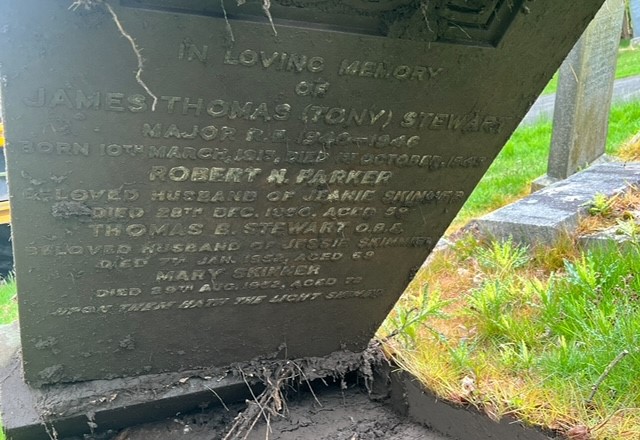
In fact, the payments continued for a number of years, with the Minutes noting Jeanie’s occasional letters of gratitude being received in L4. Then, in November 1955, she wrote again to inform Everton that she had recently inherited some money and wished for the club’s payments to her to be terminated. The board acquiesced. Jeanie Parker spent her final years residing on Gartloch Road, close to the Easterhouse development, before passing away on 13 July 1966 at the age of seventy-four. She was buried with her husband in Lambhill Cemetery.
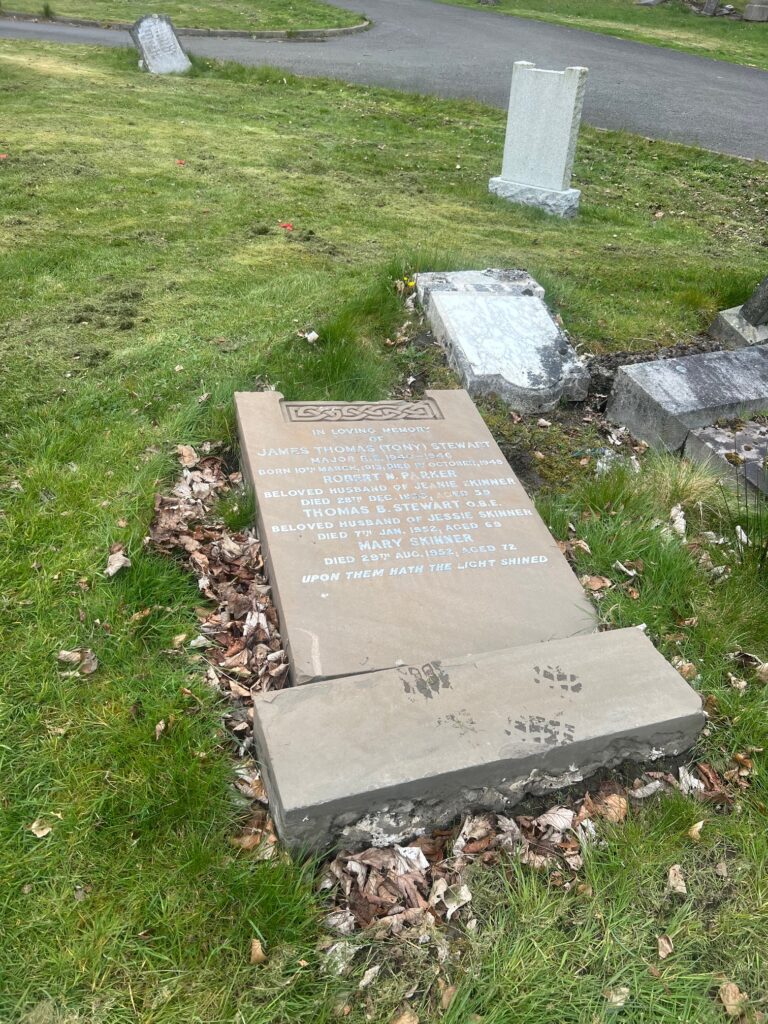
[Please see the end of this article for information about our project to restore this headstone and grave]
We can’t say with absolute certainty how things would have transpired had Bobby Parker not lost four years of his sporting life and a degree of his mobility due to the wounds sustained in 1917. There is, however, good reason to believe that continued goalscoring feats would have put him in the top bracket of centre-forwards to grace Goodison Park and English football. Instead, we are left with one glorious season in royal blue – albeit one overshadowed by war – in which the Glaswegian’s sporting brilliance earned an enduring place in Merseyside football folklore. For that, Evertonians should always be grateful.
By Rob Sawyer (2025)
Additional war time images – Mike Royden
Sources
Billy Smith, bluecorrespondent.co.uk – Newspaper reports transcribed.
George Orr, Everton Football: Champions 1914/15 ‘Over The Top’
Ken Rogers & Claire Gray, If You Know Your History (Breedon Books, 2003)
James Corbett, The Everton Encyclopedia (de Coubertin Books)
Thomas Keates, Everton Football Club 1878-1928 (1929)
David Herd, 1872 – Stories of Rangers Players of Yesteryear (DB Publishing, 2022).
abohemiansportinglife.com
Steve Johnson, evertonresults.com
The Everton Collection website
Find My Past
Acknowledgements
Gerry Farrell
Billy Smith
Peter Jones
Mike Royden
Tony Onslow
George Orr
Dave Prentice
David Herd
The Miller and Batte families
The Forest Preservation Society
Ashfield FC
Fraserburgh FC
The Restoration of Rangers Graves Project/The Founders Trail
Everton 1914/15 picture credit: Brendan Connolly
…………………………………………………………………………………………………………………………………
Bobby Parker Grave Restoration

To mark Bobby’s contribution to Everton and football, more generally, as well as acknowledging his wartime service, Everton FC Heritage Society (EFCHS) – originally prompted by member Tony Onslow – has undertaken a project to restore the grave.
The original headstone will get the TLC it needs and an additional installation will list his football clubs and military service record. The project is expected to come to in the region of £2,500, which the Society will make a contribution to. To help make up the balance, we have created a GoFundMe appeal (£1,500 target). We’d greatly value your support through a small donation to the appeal.
Bobby Parker GoFundMe Appeal – contribution page
An example of our previous work on the headstone of George Farmer;
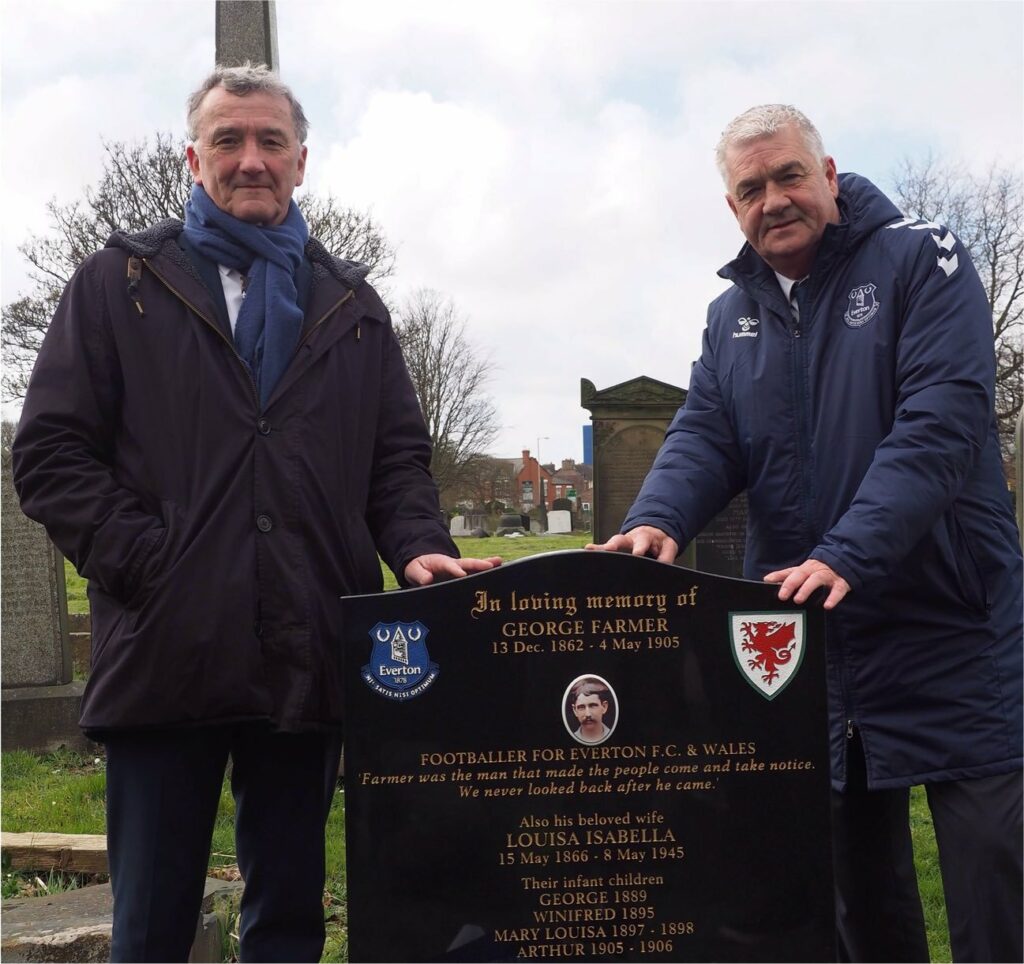
.


